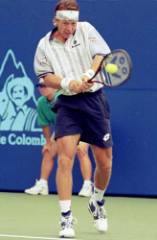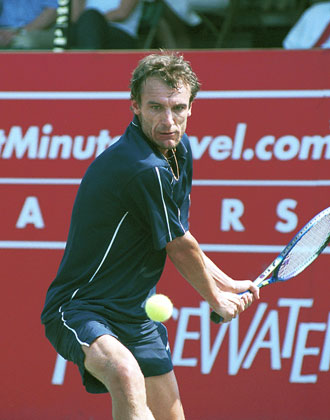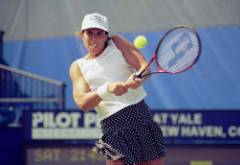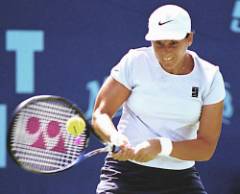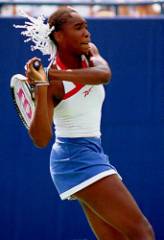February 2001 Article Turbo Tennis Archives:
Tennis Server
|

 |
Hopefully after last month’s column, you are well on your way to a better forehand. Now, we need to address the other wing. I begin with the two handed backhand for several reasons. First, in taking an inventory of what pros on both tours use, the two handed backhand is more commonly used than the one handed varieties. Since the modern game of tennis is based primarily upon solid, powerful groundstrokes, I am not surprised that the two handed backhand is so popular. I think that the new player generally gravitates to the two handed backhand because it almost always enables her/him to hit with power off this wing. In addition to power, the two handed backhand offers a player some clear advantages. Generally, the two handed backhand is more deceptive and more difficult to read. At the very last second, the player who uses two hands on the backhand can redirect the ball in any number of directions. The two handed backhand is less stance dependent than the one handed varieties. When one is playing competitive tennis, the player must be able to hit effectively, from virtually any stance…open, semi-open or closed. We cannot always get ourselves into proper position to hit from a specific stance. In my opinion, the two handed backhand is desirable because one can hit an effective shot from virtually any stance. In addition, one can actually crowd the ball or be stretched out a bit when hitting the two handed backhand. These attributes are particularly useful to the novice player who may not be able to get into proper position as quickly as a more seasoned player. Finally, I believe that timing is less critical in hitting a two handed backhand as opposed to the one handed variety. One can be a little late or a little early in making contact with the ball and still hit a shot with some measure of control. The major disadvantage to the two handed backhand is its limiting effect upon reach. It is virtually impossible to hit an effective shot using two hands when you are stretched to the limit. This is why every player must have the ability to hit a one handed backhand. Whether we like it or not, two-handed players are going to be forced to take a hand off the racquet every now and then. In addition, the one handed slice backhand is an essential shot for every player. She or he must incorporate this shot into her/his game! Mats Wilander was able to win Wimbledon and become number one in the world, after he added the one handed backhand slice to his arsenal of shots. For those of you who have hit a one handed backhand for years, I am not necessarily recommending that you try to incorporate the two handed version of this stroke. However, if you have a difficult time returning serve off this wing, hitting topspin off this wing, or if you lack power on this side…you may want to give it a try. Let’s begin our discussion with grip. Now, it is important to realize that since you are using two hands, there are two grips…one for the dominant hand and one for the non-dominant hand. There are many combinations of grips for this stroke. Some, in my opinion, are a bit more flexible than others. However, every combination of grips can and does work. This is one of the beautiful things about this stroke. I will be referring to several types of grips: continental, eastern forehand, semi-western forehand and western forehand. These were covered in last month’s column. If you are at all confused about these grips, I ask you to refer to this previously published column. January 2001-Turbostrokes: The Forehand The dominant hand should be placed in a full eastern backhand grip, eastern backhand grip, a continental grip, or what I call the Hammer Grip. Why? These grips automatically allow you to hit an effective backhand when one hand is taken off the racquet. In addition, these two grips make the imparting of topspin much easier. Why? Well, unlike most strokes, the two handed backhand can benefit from wrist action at the moment of impact. To help you envision these grips, I offer the following illustrations. Please note that the black areas on the racquet handles are the bevels. The blue areas are either the sides or top/bottom of the racquet handle. The Dominant Hand in Full Eastern Backhand Grip: In this grip palm of the dominant hand is on the side of the racquet handle. In effect, the palm is “behind” the ball as you make contact. This would be the grip that a one handed player would use to hit a topspin backhand. The Dominant Hand in the Eastern Backhand Grip In this grip, the palm is on the top bevel but still “behind” the ball. One-handed players use this grip to hit topspin, flat, and even, slice backhand shots. The Dominant Hand in the Continental Grip: The continental grip was, at one time, the “universal” grip. With this one grip, one could serve, volley, and hit both forehand and backhand groundstrokes. However, in the modern game, this grip is at best risky when used for forehand groundstrokes. It is, perhaps, the best grip to use when hitting backhand slice. The Dominant Hand in the Hammer Grip: The so-called “hammer” grip is really a tight fisted continental grip. It is given the name hammer grip because it resembles the way a person holds a hammer when hitting a nail. One can hit an effective two-handed backhand when the dominant hand uses the eastern forehand grip. However, it is a little difficult to get effective topspin when using this grip. Also, if the player is forced to take her/his non-dominant hand off the racquet, it is probable that the shot will be struck with an open face…causing it to travel high and out. For these reasons, I do not recommend it. I strongly discourage any player from having the dominant hand use a semi-western or western forehand grip when hitting a two handed backhand. These grips make for awkward swings and do not allow for one handed, “emergency” backhands. Two-handed backhands are really non-dominant hand forehands that have the added support of the dominant hand! When hitting the two handed backhand, the non-dominant hand/arm provide the power. The dominant hand serves as a stabilizing element. Look at the following pictures. Here, Lindsey Davenport is hitting the two handed backhand. Notice the muscle tension in her left arm (her non-dominant side)? By the way, her right hand (dominant side) is in a continental grip. Lindsey seems to be “crowding” the ball in this shot. Two-handed backhands are more forgiving with respect to body positioning. In this shot, we see Marat Safin as he prepares for the two handed backhand. His dominant hand (right hand) is in the eastern forehand grip. As a result, he must bend his wrist and make contact with the ball a bit behind his front shoulder. He hits the ball as one might throw a sack of potatoes over one’s shoulder. Still, his left arm/hand (non-dominant side) are doing most of the work. Jimmy Connors likes to keep his dominant hand (left hand) in the eastern forehand grip, as well. However, he tends to hit the ball flat, or at times, with slice. Thus, his wrist is not bent to get under the ball. Still, he has that “leaning into the shot” look that Safin has. Below, we see a very different look. Karol Kucera has a great two-handed backhand. His dominant hand (right hand) is in an eastern backhand grip. Notice that his left arm is fully straightened as he has already hit the ball in this shot. It provided the power in the shot. Because he chose to put his dominant hand in the eastern backhand grip, he makes contact with the ball a bit in front of his shoulder. Look at the intensity in the eyes of Bjorn Borg. Similar to Karol Kucera, Borg puts his hand in something between a full eastern backhand and eastern backhand grip. Notice, he does not have to bend his wrists to get under the ball for topspin. Borg’s was/is the prototype of the modern two handed backhand. In my opinion, the non-dominant hand should be put into the eastern forehand grip when hitting the two handed backhand. This grip allows the player to hit flat and topspin shots with ease. However, one can hit effective two-handed backhands when the non-dominant hand is in either the continental grip or semi-western forehand grip positions. Let’s take a look at some two handed grip combinations: In the above photos, the dominant hand is in the eastern backhand grip and the non-dominant hand is in the eastern forehand positions. This, in my opinion, is the best combination for topspin. In these two photos, the non-dominant hand is still in the eastern forehand grip, but the dominant hand is in the hammer grip. Again, the hammer grip is identical to the continental grip, except that the fingers are not spread out. This is the combination that I choose to use for my two handed backhand. It is, in my opinion, the most versatile combination. If you like, you can spread the fingers out on the dominant hand and make it a continental grip…the combination will not in anyway be made less effective or versatile. The two photos above show us a third combination. The non-dominant hand is still in the eastern forehand grip, but the dominant hand is also in the eastern forehand grip. This combination enables players to hit very powerful, flat backhands. Topspin requires that the player bend his/her dominant hand wrist to get under the ball. The real problem with this combination occurs when the player has to take a hand off the racquet…as is often times the case when she/he is stretched. I have deliberately shown all three sets of combinations with the non-dominant hand in the eastern forehand grip. If you are attempting to adopt the two handed backhand, you may wish to try and shift the non-dominant hand’s grip more to the semi-western forehand grip or to the continental grip. It’s really up to you. Whatever feels most comfortable and “firm.” However, upon examining many of the pro’s grip combinations, I must tell you that the overwhelming majority put their non-dominant hand in the eastern forehand grip. I need to make a final comment about grips. Generally, it is best to keep the two hands as close together as is possible when hitting the two handed backhand. However, here again, the two handed backhand is forgiving. Note in the picture below that Mikael Pernfors’ hands are not tight. The two handed backhand can be effectively hit from virtually any stance…open, semi-opened or closed. However, the best stances are closed and semi-opened. In the above picture of Mikael Pernfors, he is in a semi-opened stance. So is Slava Dosedel in this shot. However, most players like to strike the two handed backhand from a closed stance whenever possible. Here we see Mats Wilander’s famous two-handed backhand. He is striking the ball from a closed stance. Jennifer Capriati is also using a fairly closed stance in this picture. However, in the shot below, we see Monica Seles, who hits virtually all of her shots from an open stance. Remember, Monica is a lefty. So, this shot shows us her two handed backhand. If you read my column regularly, you know that I believe that a full and consistent stroke finish is essential. When hitting the two handed backhand, one wants to finish with the racquet fully over the shoulder. Here we see Venus Williams with an absolutely perfect two-handed finish. Here is Yevgeny Kafelnikov executing a good two-handed finish. So, let’s review the keys to a great two handed backhand:
Practice leaning the two handed backhand by using a backboard. It will great accelerate the learning process. However, if you use a ball machine or practice partner to learn or improve this stroke, be certain to hit to targets. Next month we will take a look at the one handed backhand slice. However, if you incorporate the two handed backhand into your game, I am certain that in no time, you will become a tennis overdog.
1996 - 2002 | 2003 - Present
This column
is copyrighted by Ron Waite, all rights reserved. Questions and comments
about these columns can be directed to Ron by using this form.
Ron Waite is a certified USPTR tennis instructor who took up the game
of tennis at the age of 39. Frustrated with conventional tennis methods
of instruction and the confusing data available on how to learn the
game, Ron has sought to sift fact from fiction. In his seven years of
tennis, Ron has received USTA sectional ranking four years, has successfully
coached several NCAA Division III men's and women's tennis teams to
post season competition, and has competed in USTA National singles tournaments.
Ron has trained at a number of tennis academies and with many of the
game's leading instructors.
In addition to his full-time work as a professor at Albertus Magnus
College, Ron photographs ATP tour events for a variety of organizations
and publications. The name of his column, TurboTennis, stems from his
methods to decrease the amount of time it takes to learn and master
the game of tennis.
|
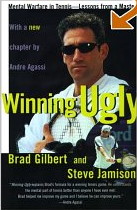

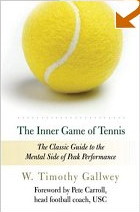
October 2022 Tennis Anyone: Patterns in Doubles by John Mills. September 2022 Tennis Anyone: Short Court by John Mills. |
 You will join 13,000 other subscribers in receiving news of updates to the Tennis Server along with monthly tennis tips from tennis pro Tom Veneziano.
You will join 13,000 other subscribers in receiving news of updates to the Tennis Server along with monthly tennis tips from tennis pro Tom Veneziano. 





















